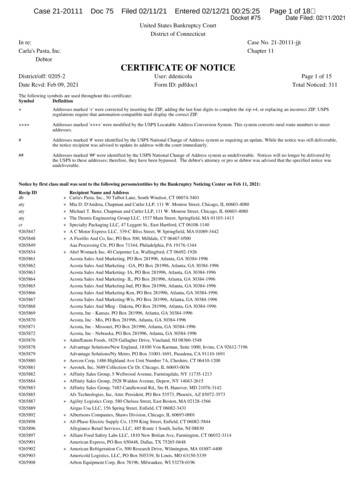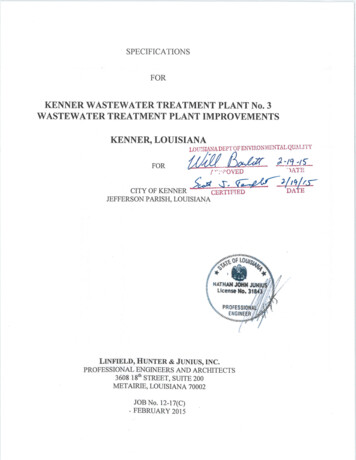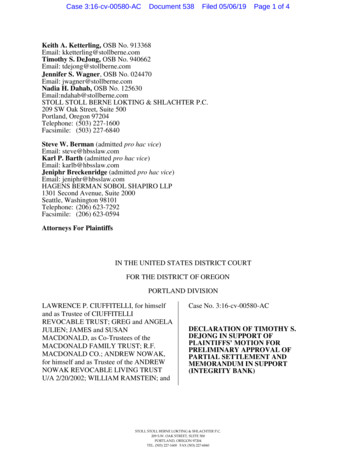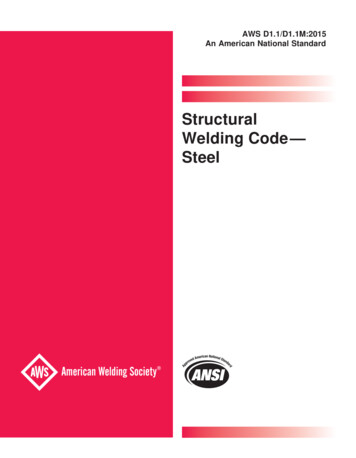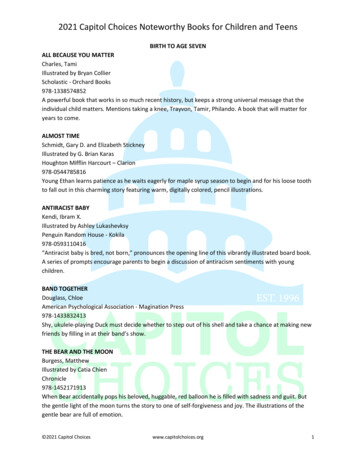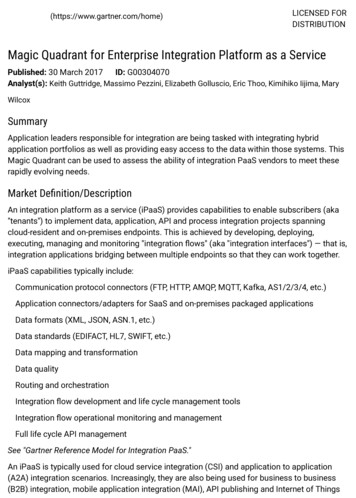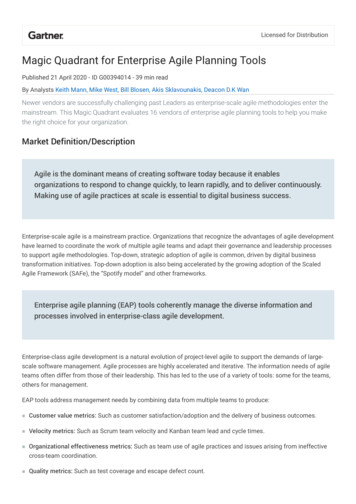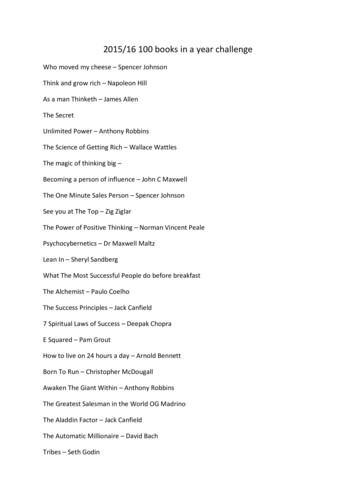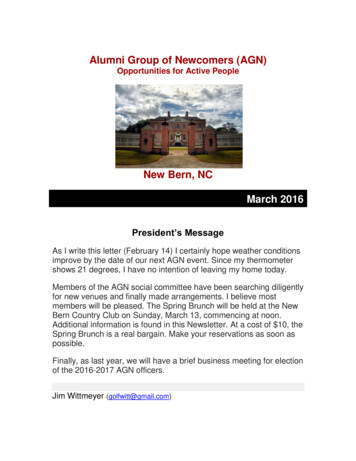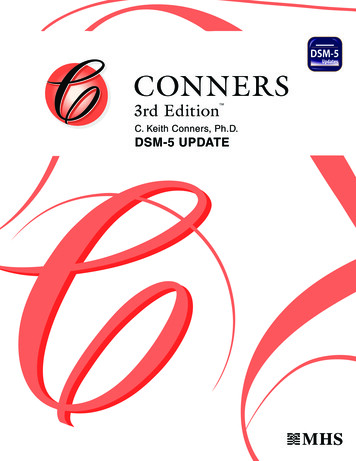
Transcription
C. Keith Conners, Ph.D.DSM-5 UPDATE
Contact MHS1-800-456-3003 (U.S.)1-800-268-6011 (Canada) 1-416-492-2627 his update was edited and typeset by David Wiechorek using InDesign CS6 and Microsoft Word 2010, using the Times New Roman, Arial, Verdana,and Myriad Pro fonts. The cover was designed by Dyan Buerano using Adobe InDesign CS6 and Adobe Illustrator CS6.Conners 3rd Edition, Conners 3, CRS–R, and QuikScore are trademarks of Multi-Health Systems Inc.DSM, DSM-IV, DSM-IV-TR, and DSM-5 are trademarks of the American Psychiatric Association.Copyright 2014 Multi-Health Systems Inc. All rights reserved. No part of this technical report, or any related materials protected by copyrights areto be printed or otherwise reproduced by any means, including electronic storage within a computer program or database, without the permission ofthe publisher. These materials may not be translated into a natural or computer language without permission. This copyright is protected through thelaws of the United States, Canada, and other countries. Persons who violate the copyrights on these materials may be liable to prosecution. Ethicalcodes of various professional associations to which users are likely to belong specifically prohibit both illegal behaviors and actions that woulddeny other parties fair compensation for their work. Persons who violate professional ethical codes related to inappropriate and unfair use of thesematerials may be brought before the relevant professional associations to which they belong. The information included in this technical report doesnot constitute, and shall not be considered, the advice, recommendation, assessment, or endorsement of MHS. To the extent permitted by law, anystatutory or implied warranty of merchantability or fitness for a particular purpose is completely denied and disclaimed. MHS shall not be liablefor any third party claims, lost profits, lost savings, loss of information, or any other incidental damages or other economic consequential damagesresulting from the use of the technical report.Published in Canada by Multi-Health Systems Inc.Printed in Canada.January, 2014
Conners 3rd Edition (Conners 3 )DSM-5 UpdateC. Keith ConnersOverviewThe Conners 3rd Edition (Conners 3 ), a revision of theConners’ Rating Scales–Revised (CRS–R; Conners, 1997),included a number of new features. One of these new featureswas direct links between scale content on the full-lengthforms (i.e., Conners 3–Parent [Conners 3–P], Conners 3–Teacher [Conners 3–T], and Conners 3–Self-Report[Conners 3–SR]) and symptom criteria in the Diagnostic andStatistical Manual of Mental Disorders, Fourth Edition, TextRevision (DSM-IV-TR; American Psychiatric Association[APA], 2000), for Attention-Deficit/Hyperactivity Disorder(ADHD), and its most common comorbid disorders, ConductDisorder (CD) and Oppositional Defiant Disorder (ODD).A new edition of the DSM was released in May, 2013: TheDiagnostic and Statistical Manual of Mental Disorders, FifthEdition (DSM-5; APA, 2013). Accordingly, a review of theConners 3 Manual and associated materials, including the fulllength QuikScore forms, the Conners 3 Software Program,and online components (e.g., the Assessment, Progress, andComparative Reports) was undertaken in order to determinethe changes required to scoring and interpretation.This update outlines the revisions to symptom criteria forADHD, CD, and ODD made in the DSM-5, as well asany changes made to forms, scoring, and interpretativeconsiderations in the Conners 3. Much of what is requiredfor administration, scoring, and interpretation of thisassessment is still found in the Conners 3 Manual. The maincomputerized scoring update to the Conners 3 assessment isa report option featuring DSM-5 scoring. Correspondingly,for hand-scoring, DSM Symptom Scales on the Conners 3QuikScore forms are updated with DSM-5 criteria. TheDSM-5 scoring option incorporates the following:i.An update to the ADHD Symptom Count for 17- to18-year-olds;ii. An amendment to the order of ODD Criterion Asymptoms; andiii. A change to the symptom count requirements on theself-report form for ODD Criterion A8 (Note: symptomcount requirements on the parent and teacher formswere not impacted by the modification to Criterion A8).Any revisions or additions to interpretative considerationsin the Conners 3 Manual and Assessment Reports (seeAppendix E, Scoring DSM-IV-TR Symptom Scales in theConners 3 Manual) are outlined in this update and printedin bold below Tables 1a through 3 (Note: The originalinterpretative considerations are included in this update tofacilitate scoring and interpretation of the DSM-5 SymptomScales). Further, interpretative considerations appear whererelevant as notes in the Assessment Reports.Changes to the Conners 3Corresponding to DSMCriteria UpdatesConners 3 DSM Scales are comprised of items thatapproximate symptom-level criteria from the DSM; fulldiagnostic criteria (e.g., course, age of onset, differentialdiagnosis, level of impairment, and pervasiveness) are notrepresented. (See the DSM-5 for full diagnostic criteria.)The itemized list of changes provided in this update detailsonly those changes in the DSM-5 to ADHD, CD, and ODDsymptom criteria that are measured, scored, and interpretedon the Conners 3. (Note: None of the changes to diagnosticcriteria for CD impact scoring or interpretation of theConners 3.)Only the Conners 3 full-length forms include the DSM-IV-TRSymptom Scales. As a result, any changes to scoring involveonly the Conners 3 full-length forms (i.e., Conners 3–Parent[Conners 3–P], Conners 3–Teacher [Conners 3–T], andConners 3–Self-Report [Conners 3–SR]). These can bescored by hand, software, or online (see the Conners 3Manual for further information about scoring). For handscoring, the DSM Symptom Scales on the Conners 3QuikScore forms are updated with DSM-5 criteria. Withrespect to computerized scoring, a DSM scoring optionis now included that allows the assessor to choose eitherDSM-IV-TR scoring or DSM-5 scoring: Reports produced using the DSM-IV-TR scoring optionare identical to the original Conners 3 reports.1
Conners 3rd Edition (Conners 3 )Interpretative Considerations: Reports produced using the DSM-5 scoring optioninclude DSM-5 Symptom Counts and interpretativeconsiderations. Inattentive, Hyperactive-Impulsive, and Combinedsubtypes were reclassified as presentations in theDSM‑5.ADHDThe following is a list of changes made in the DSM-5 to thediagnostic criteria for ADHD that required correspondingupdates to the Conners 3 assessment. Tables 1a and 1b showthe DSM-5 criteria for ADHD, the associated Conners 3form items, and the response choices for when symptomsare Indicated, May be Indicated, or Not Indicated.Response Style Analysis CONNERS 3 –TeacherScoringand ReportingAdjustments:InconsistencyIndex The names of the Conners 3 DSM Scales for ADHDwere updated to reflect this reclassification. A statement was added in the DSM-5 to the pre-amblefor both ADHD Predominantly Inattentive Presentation(Criterion A1) and ADHD Predominantly HyperactiveImpulsive Presentation (Criterion A2) that explicitlyStudent's Name/ID:requires the diagnostician to rule out “oppositionalbehavior, defiance, hostility, or failure to understandGender: MF Teacher's Name/ID:(Circle One)tasks or instructions,” as the primary causes of ADHDsymptoms. Instructions:In the DSM-5, the symptom count was reduced for1. For each of the following items, transfer the circled scores from the Scoring Grid into the appropriate boxes, below.Conduct Disorder Tobelowaddress2.olderFor eachadolescentspair of items, subtractthe lowervalue(17from thehigher andvalue andwrite the difference in the box directlyeach pair.the differential diagnosis considerationandadultsyearsolder),3. Sum the Absolute Differences to get the Inconsistency Index Total (box A).Required ScoreItemItemadded to Criterion A1 and Criterion A2, ifDSM-5the4.fromWrite theabsolute differencesthat areequalofto 2Inattentiveor 3 in box B.6numberto 5 ofsymptomsfromeachand/orMay beIndicCriterionNumberScore5. Insert a checkmark in the box provided if a possible inconsistent response style is indicated.IndicatedSymptom Count is probably met for any of theHyperactive-Impulsive presentations.12A1Item ItemItem ItemItem ItemItem ItemItem ItemItem ItemItem Item ADHDItem Itempresentations,Item ItemItem theItem assessor must ruleout 98971005263477262998105255723443489477112A2105 ItemThe changeto thesymptomcount7 for13 olderthese behaviors as the primary cause of theA3ADHD 14Score1 2adolescents (17–18-year-olds) is incorporated intoAbsolutesymptoms.considerationA41 235 This interpretative ADifferencescoring algorithms for the Conners 3 reports, such that1 2automatically appears in theConners 3 AssessmentA521InconsistencyIndex Total (A)5 symptoms are required for the Symptom Count to1 2A627Reports when the Symptom Count is probablyPossible inconsistent response style indicatedNumber of Absolute1 2be probably met for ADHD PredominantlyInattentive A733Bmet for any of the ADHD presentations (see theDifferences 2 or 3 (B)if A 6 and B 21 2A861Presentation and ADHD Predominantly HyperactiveInterpretative Considerations for Table 1a and1b, 101 2A9Presentation.ADHD Combined PresentationPI Impulsiveand NI ScaleGuidelinesDSM-5 Symptom Count and Criterion Status1 2A10 Score 90Instructions:requires 5 symptoms each from inattentive and2Requirementsfor ADHD).A11401. Transfer the Total Raw Scores for both the Positive Impression (PI) and Negative Impression (NI) Scales from the ScoringGrid into the Raw Scorecolumn of the table, below.hyperactive-impulsivesymptomForhand2. Inserta checkmark in the Interpretive Guidelinebox if thecriteria.response styleis indicated.1 2A1231 A lifespan-specific example was added to CriterionScoreInterpretiveGuideline12scoring, the QuikScore Rawformsare updatedto notetheA1554A1hin theDSM-5,Total Symptom CPositiveImpression(PI)differentsymptomcount requirements forPossibleindividualspositive response styleindicatedif RawScore 5. illustrating how the symptom ofdistractionmay present in older adolescents.16 yearsof age17 yearsof response styleNegativeImpression(NI) and younger, versus those Possiblenegativeindicated if Raw Score 5. Symptom criteria probably met if Total Symptage and older (see Figure 1). An interpretative consideration is includedNOTE:in ThetheConners 3–T does not assess Criterion A13 (staying out at n(sum all checDSM-5 Symptom Countsor Criterion A14 (running away from home). These criteria have been intmost teachers do not have the opportunity to observe these infractions.Conners 3 Assessment Report to account forthisInstructions:change (see Interpretative Considerations for Table 1a).1. For each item number listed below, transfer the circled score from the Scoring Grid into the Item Score column.2. If the Item Score is equal to a number in either Required Score column, circle that number in the May be Indicated or Indicated column.NOTE: Do not circle anything if the Item Score does not match any number in either Required Score column or if the item has been omitted.3. Insert a checkmark in the ( ) column if a score has been circled in either Required Score column.a) For ADHD Inattentive Criterion A1d, insert a checkmark only if a Required Score has been circled for both items 73 and 57.b) For ADHD Hyperactive-Impulsive Criterion A2c, insert a checkmark if a Required Score has been circled for either (or both) items 24 or 7.c) For ADHD Hyperactive-Impulsive Criterion A2e, insert a checkmark if a Required Score has been circled for either (or both) items 17 or 78.4. Count all checkmarks and write the sum in the Total Symptom Count box.5. Insert a checkmark in the box at the bottom of the table if the symptom criteria is probably met.ImpairmentInstructions:For each item listed in the Impairment table below, refer to theFigure1. referConners3–TeacherQuikScoreForm -thatSymptomRequirementsNOTE: Pleaseto the Conners3 Manual and DSM-5Update for exceptionsmay alter the CountTotal SymptomCount.ADHD InattentiveC. Keith Conners, Ph.D.DSM-5CriterionItemNumberItemScoreRequired ScoreMay beIndicated( )IndicatedDSM-5CriterionItemNumberItemScore113. The student’s problems seriously affect f60A1g9223A1h2323A1i8823A1d2BOTH itemscircled3Total Symptom Count(sum all checkmarks) Age 16; Symptom criteria probably met if Total Symptom Count 6 Age 17; Symptom criteria probably met if Total Symptom Count 5ADHD Combined 2923A2eA2f( )IndicatedA1b69112. The student’s problems seriously affect schoolwoRequired ScoreMay beIndicatedA1aA1c2ItemADHD Hyperactive-ImpulsiveEITHER itemcircledEITHER itemcircledTotal Symptom CountConners 3 ADHD IndeInstructions:1. For each item listed below, transfer the circled score from th2. Transpose each score by following the Transposing Rule an3. Sum the transposed scores to obtain the Total Transposed4. Determine the probability of a classification of ADHD by circItem4Item7Item130, 1 2 3 0 1 20, 1 2 3 0 1 2StatementsforItem Scoredetermining if 0,the1 2TotalTransposingSymptom Rule0 1Countis probablyTransposedmet. Score3 2Total Transposed Score012345Probability (%)19395152586 0 (sum all checkmarks) Age 16; Symptom criteria probably met if Total Symptom Count 6 Age 17; Symptom criteria probably met if Total Symptom Count 5Symptom criteria probably met if symptom criteria probably met for ADHD Inattentive andADHD Hyperactive-ImpulsiveConners 3
DSM-5 UpdateCDScoring and Reporting Adjustments: Criterion A in the DSM-5 divides ODD symptomRevisions made in the DSM-5 to the diagnostic criteria forcriteria into three types of behaviors, including Angry/CD did not impact Criterion A symptoms (those symptomsIrritable Mood, Argumentative/Defiant Behavior, andassessed by the Conners 3); they are essentially identical toVindictiveness. As a result of this change, diagnosticthoseprinted in the DSM-IV-TR. Table 2 shows the DSM-5Conners 3–T Assessment Report for TestAdmin Date:11/11/2013criteria for ODD were reorderedas follows:criteria for CD, the associated Conners 3 form items, and theresponsechoicesfor when symptomsare Indicated, May beDSM-5ConductDisorder Criterion A1 in the DSM-5 is in the same order it wasIndicated,or Not Indicated.the DSM-IV-TRDSM-5 Symptoms:Criterion AItemTeacher's inRatingCriterion StatusAggression to People and AnimalsNumber 012Scoring and Reporting siderations:35A4.A5.changes were made to the interpretative21considerationsNoforCD. Table 2 includes interpretative considerationsfor CDA6.27thatA7. apply to the DSM-5 Symptom Scales;33however, thesenotesare identicalto the interpretative considerations forDestructionof PropertytheDSM-IV-TRSymptomScales. The notesA8.61are provided inthissupplementtofacilitateinterpretationof the SymptomA9.10CountforDSM-5scoring.Deceitfulness or Theft3? Criterion A2 in the DSM-5 was Criterion A6 in theDSM-IV-TRIndicatedü CriterionA3inthe DSM-5 was Criterion A7 in theIndicatedüDSM-IV-TRIndicatedü CriterionA4inthe DSM-5 was Criterion A2 in theIndicatedüDSM-IV-TRIndicatedüIndicatedü CriterionA5 inthe DSM-5 was Criterion A3 in theDSM-IV-TRIndicatedü Criterion A6 in the DSM-5 was Criterion A4 in theIndicated¹üDSM-IV-TRIndicated¹ü Criterion A7 in the DSM-5 was Criterion A5 in theDSM-IV-TRA10.90Indicatedü Criterion A8 in the DSM-5 is in the same order it wasA11.40IndicatedüODDin the DSM-IV-TRA12.31IndicatedüTable 3 shows the DSM-5 criteria for ODD, the associated In the Conners 3, symptom criteria are reorderedSerious Violations of RulesConners 3 form items, and the response choices forand ülabeled as theyare in the DSM-5 (i.e., Angry/A15.54Indicated²when symptoms are Indicated, May be Indicated, or NotIrritable Mood, Argumentative/Defiant Behavior, and¹Both ctionwere indicated. In order to meet Criterion of property)Vindictiveness; see Figure 2) in all of the ODD tablesthe assessor must confirm that property was destroyed other than by fire-setting (Criterion A8).and scoring of the Conners 3 scales, and some otherin the reports. Similarly, the change to the order ofinterpretativeconsiderations.symptomcriteriafor ODDis incorporated²In order for CriterionA15 (truancy) to be indicated the assessor needsto ensurethis criterionoccurredbefore theintoagetheof 13 years.ODD table in the DSM-5 Symptom Counts section ofthe QuikScore forms (see Figure 3).Note: The Conners 3–T does not assess Criterion A13 (staying out at night without permission) or Criterion A14(running away from home), as most teachers do not have the opportunity to observe these infractions.Figure 2. Conners 3–Teacher Assessment Report - DSM-5 Symptom TableDSM-5 Oppositional Defiant DisorderDSM-5 Symptoms: Criterion AAngry/Irritable MoodItemNumber 0A1.62A2.56A3.38Teacher's tative/Defiant nessA8.Criterion dSymptom criteriareordered and labeled.3
Conners 3rd Edition (Conners 3 )Age:/ /Name/ID:Birth Date:(CircleOne)MonthDayYearConduct DisorderOppositional Defiant DisorderItem61Item25ItemNumberItemA138A2 A3A167A224 A1nt response style A4indicated 3A562A674e Raw Score column of the table, below.A787A894Score 4.w Score 5.t 325A359 286213A872A982A1078113347A6( ) May beIndicated338A4A5InconsistencyIndex Total (A)2DayYearMonthDayYear23233A1116 2A1252A1391 2A148A15332Oppositional Defiant DisorderRequiredScoreChange1( )toIndicatedorder ofcriteria.2 3[Note:Thereare2 3differentitem1 2 3numbersfor1 2 3criteriaA2to1 2 3A7in table (a)1 2 3vs. (b)].2 31231232 3 toChange1 2 3criterion12 score3status1 2 3requirementsfor ODD12 3CriterionTotal SymptomCount A8.33Total Symptom CountTrim parts 2, 3, 4 & 5 to 17.125 in.Item43Required ScoreItemItemItem DSM-5May ight 2008 Multi-Health Systems Inc. All rights reserved. In the United States, P.O. Box 950, North Tonawanda, NY 14120-0950, 1-800-456-3003.In Canada, 3770 Victoria Park Ave., Toronto, ON M2H 3M6, 1-800-268-6011, 1-416-492-2627, Fax 1-416-492-3343.DSM-IV-TRCriterion( )Month/ /(b) DSM-5 Symptom Scale(a) DSM-IV-TR Symptom Scaleair.Birth Date: / /YearsMonthsMonthQuikScoreDayYearConners 3–Self-ReportFormFGrade:and Criterion Status Score RequirementsAdministration Date:AdministrationDate:ChangetoGender:OrderofM / /SymptomCriteriaRequired 8723A42423A51A6323A76223A89423May beIndicated2 metSymptomprobably Symptom criteria probablyif TotalcriteriaSymptomCountmet 4if Total Symptom Count 33231Total Symptom Count(sum all checkmarks)(sum all checkmarks)(sum all checkmarks)( )Indicated Symptom criteria probably met if Total Symptom Count 4NOTE: The Conners 3–SR does not assess Criterion A7 (forced sexual activity). This criterionhas been intentionally omitted due to the sensitive nature of this criterion.criterionSummary In the DSM-5, a frequency qualifier was added toCriterion A8 of “atImpairmentleast twice within the past 6Instructions:Withtheof the DSM-5, it was necessary to reviewmonths,”forspitefulor itemvindictivebehavior.items31 orFor eachlisted in the Impairmenttable below, refer to the Scoring Gridand circlethe releasescore.dh)andcirclethe39.score.1 and 17.the Conners 3 Manual and associated materials (i.e., the(or both) items 20 or 7. 55.Criterion status score requirements are updated on theImpairment(or both)items 66 orImpairmentQuikScoreforms, Conners 3 Software Program, andNot true at all/ Just a little true/ Pretty much true/ Very much true/Conners3–SRaccommodatefrequencyNot trueat all/ Justa littletotrue/Pretty much true/theVerymuch true/ qualifierItemneveroccasionallyveryneedoften toonlinecomponents,includingreports)oftento assess theneveroccasionallyoftenvery oftenadded to Criterion A8 (see Figure 3). Specifically, for01 Scales. This2 review led 3to the95. I have problemsthat make schoolreally hard for me.updatetheDSMSymptom0123or vindictive behavior to betive-Impulsive the symptom of spiteful12396. I have problemsthat make friendshipsreally hard for me. determination0that with some0123small modificationsscoringclassified as Maybe Indicatedon the Conners3–SR,Required Score012 Scales could397. I have problemsthat make thingsreally hard for me at home.0123me.andinterpretationoftheDSMSymptombe( )May beIndicateda response of 1 [Just a little true (Occasionally)] -5.Therequired. Previously, a response of 1 was classified as23Conners 3 ADHD Index Conners 3 Manual contains most of the material required to2 3 Not Indicated. However, it was determined that theInstructions:administer,score,1. Foritemtruelisted below,transfer the circled scorefrom the Scoring Gridinto the Item Scorerow. and interpret the assessment. This update3 row.frequency of “Justa eachlittle(Occasionally)”appliesGrid into the Item2Score2. Transpose each score by following the Transposing Rule and enter the score into each Transposed Score box.score into each 2TransposedScore box.3 betterreportingandscoringchanges, and interpretative3. Sumthe transposedto obtain theTotal Transposedcircle this scorein the ProbabilityScoretable.to atable.behaviorthatmeets scoressymptomcriteriaif Score, thendetailscircle this score in the ProbabilityScore4. Determine the probability of a classification of ADHD by circling the corresponding Probability score.2 3 score.esponding Probabilityconsiderations that need to be taken into account when usingit occurs at least twice within the past 6 months.1 Item2 3ItemItem em6 63 not change9213435435061 interpret63DSM-5symptomcriteriato scoreandthe DSMSymptomdidon15the43 count50requirements613 352 34Item ScoreSymptom Scales on the Conners 3.2 3 Conners 3–P and Conners 3–T; existing criterion2 1 32 30, 1 2 30, 1 2 30, 1 2 30, 1 2, 30, 1 2, 30, 1 2 30, 1 2, 30, 1 2, 3 0, 1 2 30, 1 2, 30, 1 2, 30, 1 2 30, 1 2, 30, 1 2, 0,3 1 0,2 3 status score requirementsfor this frequencyTransposing Ruleaccount of 0 1 20 1 201020 1 201020 1 201 2 03 spiteful20 or1 2vindictive0102 0 10 21 2 0 1 2behavior.Transposed Score d column.s been omitted.EITHER itemcircledEITHER itemcircled 23 otal Symptom Count TotalTransposedScoreTotalInterpretative Considerations:TransposedScore(sum all checkmarks)et if Total Symptom Count 6 Criterion A now states that the symptoms that defineConners 3 ADHD Index Probability ScoreTotal TransposedScore interactionmustbe “exhibitedduringwith3 at least0161172184567891011678 ODD9101112131415Probability (%)5966737883879194DHD 78Inattentiveand7383 one87 individual9194 who9697 not98a sibling.”98 2699 3599 4499 52iset if TotalIndexSymptomProbabilityCount 5DHDScore To address this change, the following interpretativeconsideration should be taken into account when theSymptom Count is probably met for ODD: “ODDCriterion A states that symptoms must be exhibitedduring interaction with at least one individual who is not asibling. If the Symptom Count is probably met for ODD,follow-up is recommended to ensure this requirement issatisfied” (see Interpretative Considerations for Table 3).This interpretative consideration automatically appears inthe Conners 3 Assessment Reports when the SymptomCount is probably met.41213141516171896979898999999Trim parts 2, 3, 4 & 5 to 17.125 in.FigureMonths3.YearsCopyright 2008, 2014 Multi-Health Systems Inc. All rights reserved. In the United States, P.O. Box 950, North Tonawanda, NY 14120-0950, 1-800-456-3003.In Canada, 3770 Victoria Park Ave., Toronto, ON M2H 3M6, 1-800-268-6011, 1-416-492-2627, Fax 1-416-492-3343.Age:
1a1b1c1d1e1f1gOften fails to give close attention to details or makes carelessmistakes in schoolwork, at work, or during other activities (e.g.,overlooks or misses details, work is inaccurate).Often has difficulty sustaining attention in tasks or playactivities (e.g., has difficulty remaining focused during lectures,conversations, or lengthy reading).Often does not seem to listen when spoken to directly (e.g., mindseems elsewhere, even in the absence of any obvious distraction).Often does not follow through on instructions and fails to finishschoolwork, chores, or duties in the workplace (e.g., starts tasksbut quickly loses focus and is easily sidetracked).Often has difficulty organizing tasks and activities (e.g., difficultymanaging sequential tasks; difficulty keeping materials andbelongings in order; messy, disorganized, work; has poor timemanagement; fails to meet deadlines).Often avoids, dislikes, or is reluctant to engage in tasks thatrequire sustained mental effort (e.g., schoolwork or homework; forolder adolescents and adults, preparing reports, completing forms,reviewing lengthy papers).Often loses things necessary for tasks or activities (e.g., schoolmaterials, pencils, books, tools, wallets, keys, paperwork,eyeglasses, mobile telephones).DSM-5 Criterion AI have trouble keeping myself organized.Avoids or dislikes things that take a lot of effort and are not fun.Avoids or dislikes things that take a lot of effort and are not fun.I don’t like doing things that make me think hard.SRPTSRTSRPHas difficulty organizing tasks or activities.TLoses things (for example, schoolwork, pencils, books, tools, ortoys).Loses things (e.g., schoolwork, pencils, books, tools, or toys).I lose stuff that I need.Has trouble organizing tasks or activities.I have trouble finishing things.I have trouble following instructions.PSRTHas trouble keeping his/her mind on work or on play for long.Has trouble keeping his/her mind on work or play for long.I have trouble keeping my mind on what I am doing.Does not seem to listen to what is being said to him/her.Does not seem to listen to what is being said to him/her.I have trouble keeping my mind on what people are saying to me.Does not follow through on instructions (even when he/she understands and is trying to cooperate).Fails to complete schoolwork, chores, or tasks (even when he/sheunderstands and is trying to cooperate).Does not follow through on instructions (even when he/sheunderstands and is trying to cooperate).Fails to complete schoolwork or tasks (even when he/sheunderstands and is trying to ��–––1, 01, 01, 01, 01, 01, 01, 01, 01, 01, 0-or1,01, 0-or1,01, 0-or1,0–2––––––1, 0-and1, 01, 01, 01, 01, 01, 01, 01, 01, 0–––NotIndicatedTable continued next page.3, 23, 23, 233333, 23, 23, 2-and3. 261-and17843, 2-and3. 273-and573, 2-and3. 268-and79PPTSRPTSRI make mistakes by accident.3, 2-or33, 23, 23, 23, 23, 23, 231-or399511163356942It is hard for me to pay attention to details.SR3, 23, 237Doesn’t pay attention to details; makes careless mistakes.47Doesn’t pay attention to details; makes careless mistakes.Item #TItemIndicatedPFormMay beIndicatedTable 1a. DSM-5 Symptom Count and Criterion Status Score Requirements for ADHDDSM-5 Symptom Count Requirements: ADHD Predominantly Inattentive Presentation: At least 6 of the 9 symptoms for individuals 16 years of age; at least 5 of the 9 symptoms for individuals 17 years of age. ADHD Combined Presentation: Meets criteria for both Inattentive and Hyperactive-Impulsive presentations.DSM-5 Update5
6DSM-5 Criterion A1haForm(Continued) DSM-5 Symptom Count and Criterion Status Score Requirements for ADHDItem101237728832Item #Indicated3, 23, 233, 23, 23May beIndicated––2––21, 01, 01, 01, 01, 01, 0NotIndicatedaCriterion A1h states that in older adolescents, the tendency to be easily distracted by extraneous stimuli may include unrelated thoughts as the source of distraction. Follow-up is recommended tocheck if Criterion A1h has been met for older adolescents.ADHD Criterion A states that symptoms are not solely a manifestation of oppositional behavior, defiance, hostility, or failure to understand tasks or instructions. If the Symptom Count is probably metfor ADHD Predominantly Inattentive, Hyperactive-Impulsive, or Combined Presentation, follow-up is recommended to ensure this requirement is satisfied.Interpretative Considerations:The following response key applies to the criterion status score requirements noted in the Indicated, May be Indicated, and Not Indicated columns: 0 Not true at all (Never, Seldom);1 Just a little true (Occasionally); 2 Pretty much true (Often, Quite a bit); 3 Very much true (Very often, Very frequently).P parent; T teacher; SR self-report.Notes:Is often easily distracted by extraneous stimuli (for olderadolescents and adults, may include unrelated thoughts).PIs easily distracted by sights or sounds.TIs easily distracted by sights or sounds.SR I get distracted by things that are going on around me.PIs forgetful in daily activities.Is often forgetful in daily activities (e.g., doing chores, runningerrands; for older adolescents and adults, returning calls, paying1iTIs forgetful in daily activities.bills, and keeping appointments).SR I forget stuff.DSM-5 Symptom Criteria reprinted with permission from the Diagnostic and Statistical Manual of Mental Disorders, Copyright, 2013. American Psychiatric Association.Table 1a.Conners 3rd Edition (Conners 3 )
2a2b2ca2d2e2fOften fidgets with or taps hands or feet or squirms in seat.Often leaves seat in situations when remaining seated is expected(e.g., leaves his or her place in the classroom, in the office or otherworkplace, or in other situations that require remaining in place).Often runs about or climbs in situations where it is inappropriate.(Note: In adolescents or adults, may be limited to feeling
a report option featuring DSM-5 scoring. Correspondingly, for hand-scoring, DSM Symptom Scales on the Conners 3 QuikScore forms are updated with DSM-5 criteria. The DSM-5 scoring option incorporates the following: i. An update to the ADHD Symptom Count for 17- to 18-year-olds; ii. An ame
